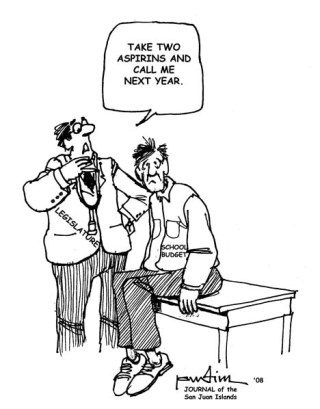We have to search for words that appropriately express our gratitude to the donors who have given so much to help our local schools through this financial crisis. As of Friday, six donors had given $285,000 to help make up some of the school district’s projected budget shortfall, and islanders contacted by phone in Thursday’s phone-a-thon had pledged $55,000 more.
School district officials and representatives of the San Juan Public Schools Foundation and the San Juan Island Community Foundation were working over the weekend to raise an additional $260,000 to erase the shortfall.
We are stunned once again by the generosity of this community. And so we say, “Thank you.”
This budget shortfall is blamed on three factors: One, declining enrollment. Two, the spending down of the district’s fund balance. Three, a shortfall in state funding for state voter-mandated salary increases for teachers.
We have little doubt that the current financial crisis will be resolved. Our thoughts now turn to the 2009-2010 budget. And here are some issues that must be part of the discussion:
On the local level, the school district must evaluate its policy of “paying down” its fund balance to 5 or 6 percent of revenue. Last year, the district had a fund balance of $753,000 – 9.69 percent of revenue.
To us, “fund balance” sounds like “surplus” and “paying down” sounds like “spending.”
The district spent its surplus on a vice principal position at the high school, a full-time custodian, special education aides and a secretary, among other expenses. In a district with declining enrollment, where 80 percent of the budget is spent on employee salaries and benefits, most of that money should be socked away to protect against future unexpected financial blows.
Second, local school officials and supporters give state legislators a lot of heat for failing to fund “a state mandate,” as if the state Legislature made a requirement but didn’t fund it. But Initiative 732 was not a “state mandate.” It was a voter mandate, approved by Washington voters.
Welcome to the dangers of government-by-initiative.
Our advice: Be careful what you wish for. I-732 not only mandated annual cost-of-living increases for public school teachers, but also for teachers and classified employees at community and technical colleges.
By the way, note the term “Cost-of-living increases.” We can blame the state for not fully funding those increases, but other increases are our own. The shortfall passed on to San Juan was $150,000. But locally negotiated agreements and other salary obligations boosted San Juan’s salary budget by $265,000 — far less than the so-called fund balance spend-down.
Third, San Juan County’s school districts need to determine other ways they can work together to save money. Orcas and San Juan share a business manager; there must be other positions and services we can consolidate.
Fourth, the Washington Interscholastic Athletic Association must revisit district boundaries for sports. Fuel costs and other costs associated with sports travel will only continue to rise. Districts must be designed around geography.
Currently, some districts make no sense and, the way they are structured, teams are forced to travel. Friday Harbor’s soccer team is alone in its own district. Friday Harbor and Coupeville are in their own league for tennis.
There were 15 games in seven sports scheduled last week. Of those, Friday Harbor hosted four.
In short, the school district needs to do what those hard-working families it hit up for donations do: Spend wisely, look for ways to work smarter, and save when you can because you never know what could happen tomorrow.



